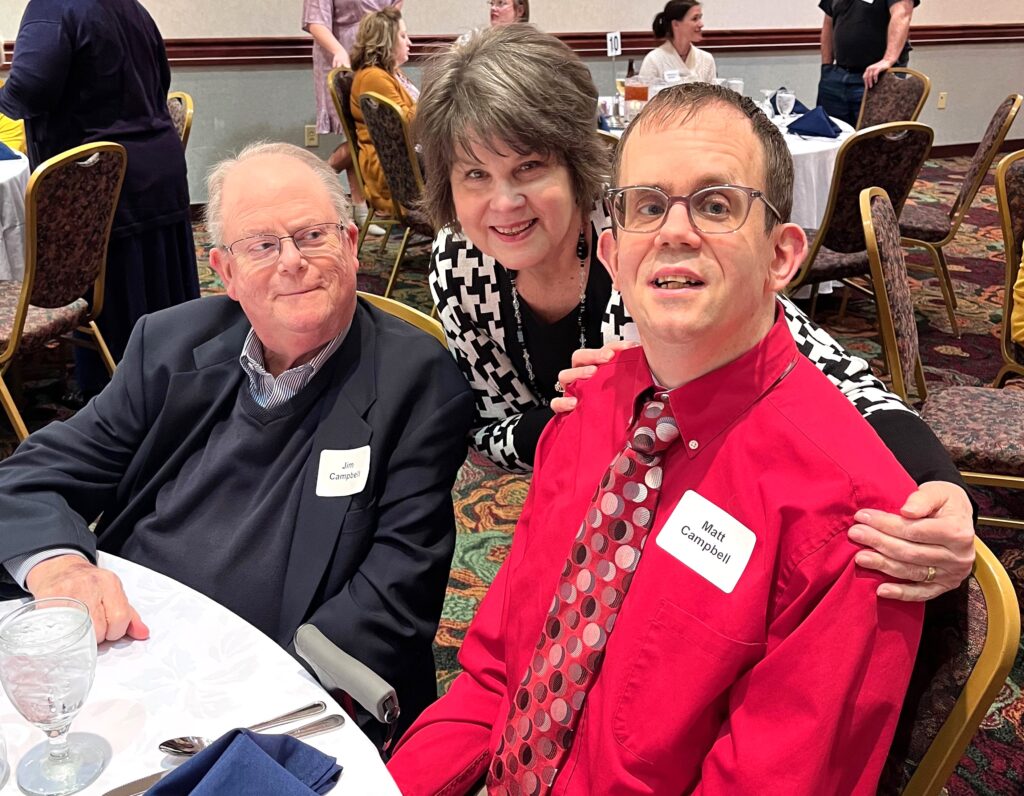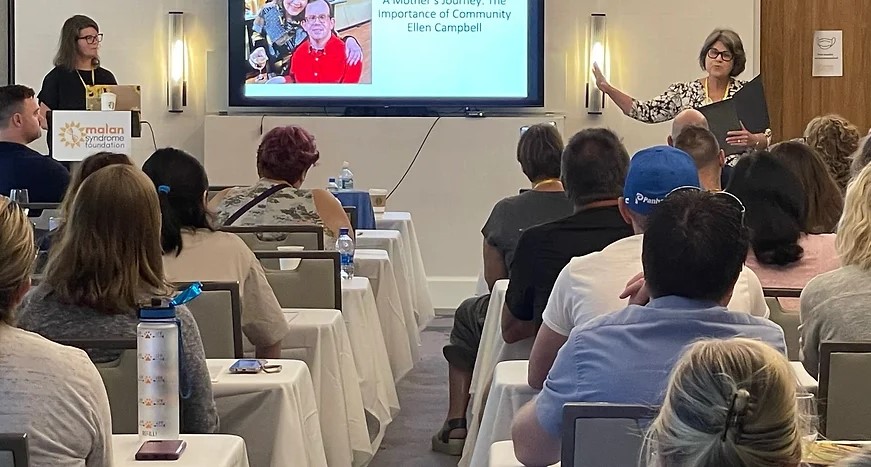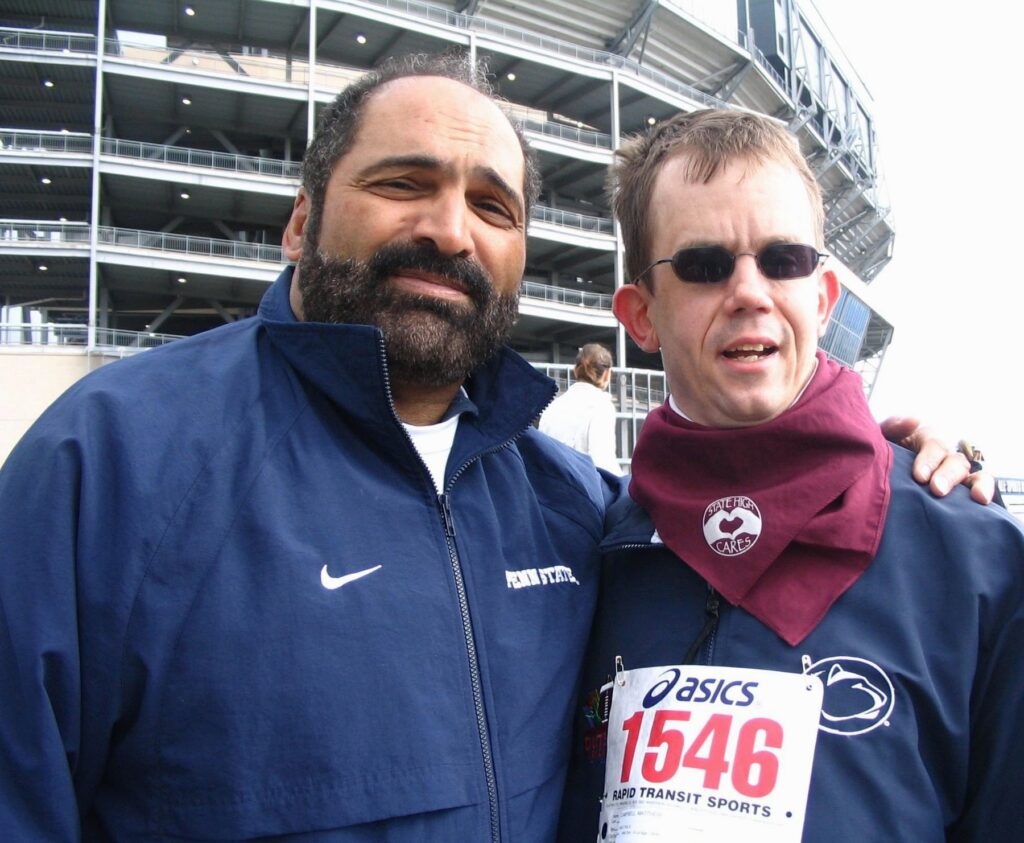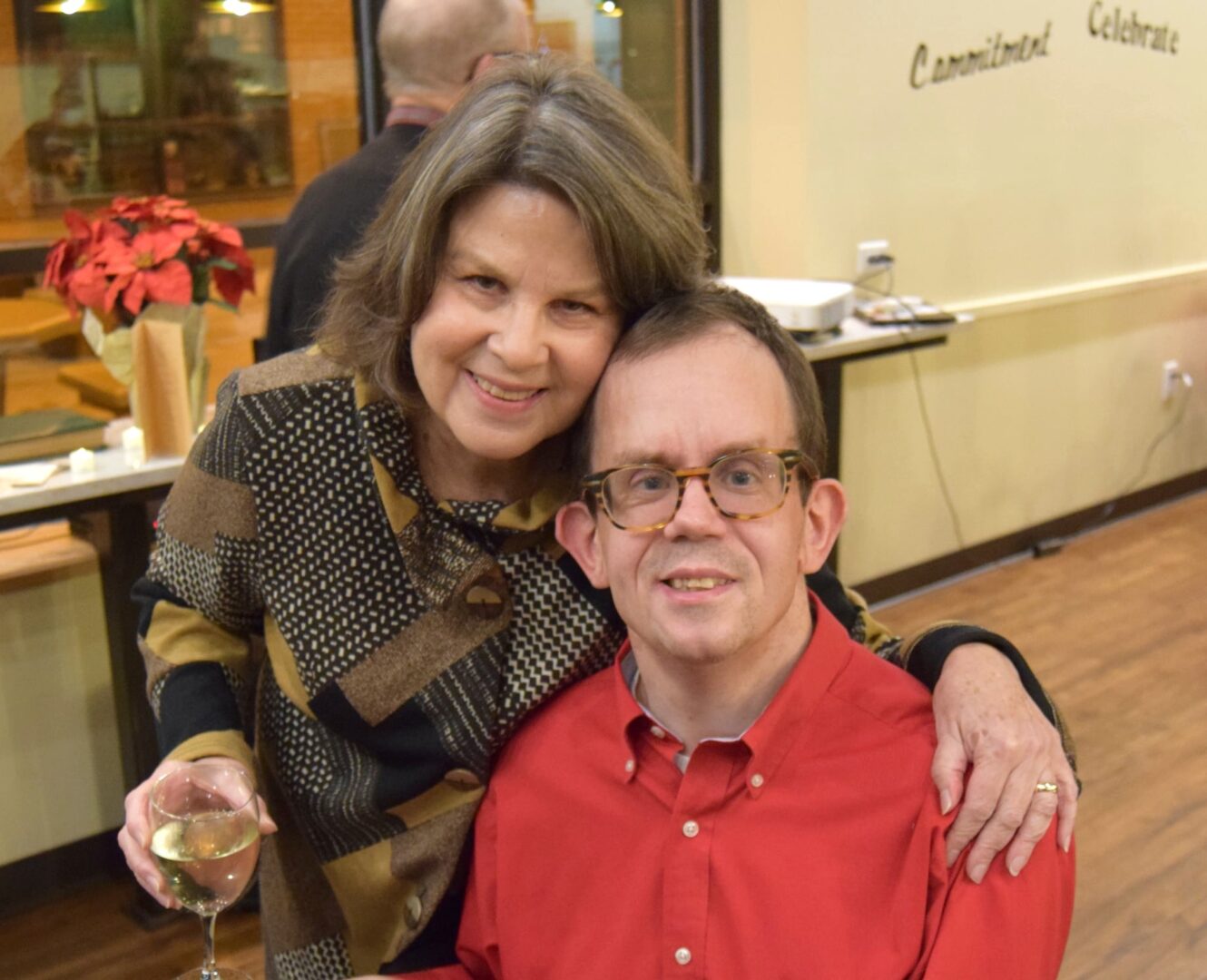Matthew James Campbell entered the world at Centre Community Hospital on October 13, 1972. His parents, Jim and Ellen Campbell, will never forget that date though 50 years have gone by. “Our hearts were overjoyed to begin our family with this firstborn son,” says Ellen.
The little boy seemed normal and healthy at first, though the attending physician took note of his large head and his marginal APGAR score—a measure used to evaluate the health of a newborn.
But it didn’t take long for additional concerns to surface. “He lagged behind on all the milestones,” Ellen recalls. “Lifting his head, rolling over, sitting up, crawling, walking and talking. When he finally did meet milestones, the way he sat, the way he crawled and the way he walked did not look to me like other children.”
At the age of 2, Matthew was examined at Johns Hopkins Hospital. The conclusion from a pediatric neurologist was not one the Campbells wished to hear. The doctor told them that “our son clearly had an intellectual disability and that the future was one where he would probably never read, write, live or work independently.”
“We were simultaneously gobsmacked and heart broken,” says Ellen, my long-time friend and classmate from State College High School’s class of 1970. “I clearly remember that long car ride home back to York (the Campbells lived in York and in Luzerne County before returning to their State College hometown in 1993). It was the week before Thanksgiving and I told Jim, ‘I am never going to celebrate again.’”
AN ONGOING MYSTERY
As the decades came and went, Matthew did achieve some breakthroughs, despite the overall accuracy of that physician’s diagnosis. And his parents, together with his siblings, Barbara and Rob, have celebrated Thanksgiving with great joy on many occasions. But despite the family’s love for him and pride over his hard-fought steps of progress, the mystery of Matthew’s malady hung over their heads.
What had gone wrong? Without knowing the genesis of Matt’s disability, it was at times challenging to make medical decisions. And without knowing the cause of his limitations, it was difficult to deflect unfounded feelings of guilt—a tendency for caring parents like the Campbells.
“There was a diagnosis that he had an intellectual disability,” says Ellen, “but I wanted to know what happened. Was it something that happened when I was pregnant? Was it something that happened during birth? And nobody could ever tell us.”
Then a near-tragedy came upon Matthew, but somehow it led to several wonderful outcomes.

THE MYSTERY IS SOLVED
A variety of troubling issues showed up for Matthew Campbell during the latter half of 2021. He no longer wanted to leave his Strawberry Fields group home. In fact, he didn’t want to leave his room. He couldn’t swallow, so a feeding tube was needed. Jim would observe periods of blank stares, and he wondered if his son was having epileptic seizures. “He was shutting down, physically and mentally,” says Ellen.
After gastrointestinal tests, brain imaging and visits to a psychiatrist and a neurologist, the Campbells agreed with their physicians that genetic testing should be conducted.
And there it was, in February of last year: the answer to the mystery of almost 50 years. Matthew was diagnosed as an individual with Malan’s Syndrome, making him the oldest-known person to be genetically identified with this rare disease that affects perhaps one in every 1 million people. Malan’s (pronounced “meh-LAWNS”) Syndrome typically manifests itself in intellectual disability, speech delay or inability to speak, hearing and vision impairment, tall stature, large head circumference, seizures and anxiety.
Armed with a long-awaited diagnosis, the Campbells and their team of physicians put Matthew on the road to recovery last spring—via seizure medications—and he’s returned to his original baseline. As for his parents, they’ve gained an added boost from learning the identity of the condition they’ve battled for all these years.
NO GUILT, NEW TRIBE
“When I heard the news from the geneticist,” says Ellen, “I felt a huge sense of relief. This was actually news we had waited 49 years to hear—the reason for all the delays, all the struggles, all the issues. One of my first thoughts was, ‘It’s not my fault.’”
But not only did the Campbells find inner relief from Matthew’s diagnosis. Learning of his status as an individual with Malan’s Syndrome also gave them entrée into a supportive network of researchers, physicians and parents.
“For me,” says Jim, “there was something special about being included in this group we didn’t know anything about.”
“We didn’t know there was a group to be part of,” notes Ellen. “It’s like we found our tribe.”
LEARNER AND LEADER
And then it was July 22-24 of last summer, a year ago this week, when the Campbells traveled to Chapel Hill, North Carolina for the Malan Foundation’s first-ever Malan Syndrome Family and Scientific Engagement Conference. To say the least, their eyes were opened as they joined a gathering of 200 people who were somehow connected with this rare condition. Matthew, still recovering from his previous decline, did not attend.
It was an emotional time, with sobering moments and joyful moments. But most of the experience was educational as parents learned about the common effects of Malan’s and received a daunting checklist of the types of physicians to consult: orthopedic specialist, neurologist, ophthalmologist, cardiologist, gastroenterologist. But the Campbells weren’t surprised; they had found their way to all those specialties. “I could have written that list,” Ellen says with a chuckle.
Given her decades of experience with Malan’s and her professional background as a teacher (she taught English at State High from 1993 to 2011), Ellen was asked to give a presentation at the conference. According to Jim, “She was a rock star after that presentation,” drawing small crowds of parents during mealtimes. Her goal, which was clearly accomplished, was to offer a realistic but encouraging look at the future.
“I think the main thing was to give people hope,” she says. “So I talked about what Malan’s looked like in Matthew’s teen years, in his 20s and 30s. And I talked about his special ed experience here (in State College) and then I talked about him getting a job when he graduated from high school. I didn’t want to sugarcoat it, so I also talked about his limitations and challenges.”

POSITIVE PENNSYLVANIA RESOURCES
It was Ellen’s description of the services offered in various Pennsylvania communities that captured much of the attention. In York, Matthew received speech, occupational and physical therapy at age 2 through the Easter Seal Society, and then he began early intervention at age 3. At age 6, he became the first York County special ed student to be totally included in kindergarten, and Ellen is convinced that the teacher’s use of phonics made a big contribution to his later breakthrough in reading.
The family moved to Luzerne County when Matthew was 8, and within a few years he achieved a breakthrough by learning to read at the second grade level. Ellen, meanwhile, got connected to The Arc and that involvement led to her serving on the organization’s state board and beginning to advocate with state government on behalf of the disabled.
TRANSFORMATION IN STATE COLLEGE
But clearly, the Campbells’ 1993 move back to State College was crucial, putting Matthew’s development into high gear. “Matthew had only two years left before he graduated from high school,” says Ellen, “but I am not sure he ever lived two more transformational years.”
It all started with a wonder-working teacher named Terri Lindner who led the “Wild Dream Team,” the special education class at State High. Linder, honored as Disney’s “American Teacher of the Year” in 1999, believed in dreaming big, and she taught her students to do the same. Thus, they rallied around the idea of visiting a dude ranch in Arizona and they helped with the fundraising and planning for the trip—while developing their reading, writing and math skills in the process.
Another class dream led to the rental of an apartment with staff hired to stay overnight with the students and to coach them in cooking, shopping and cleaning. According to Ellen, “I still remember dropping Matthew off at the apartment for his first overnight visit. That letting-go moment was very difficult.”
But still the growth in practical living skills continued for Matt Campbell as he began working part-time at Mike’s Video. It took some help from a job coach to create a visual system for alphabetizing videos, but Matthew earned his first paycheck by reshelving videos. After several years with Mike’s, Matthew landed a new part-time job at Penn State’s Natatorium where he washed, dried, folded and distributed towels.
HOME AWAY FROM HOME
The biggest step of all—one that truly impressed Ellen’s conference listeners—came in 1997 when Matt changed his place of residence. Strawberry Fields, the wonderful local organization that blesses those with intellectual disabilities and those with mental health challenges, was opening a new group home. They contacted the Campbells to see if this home might be an appropriate place for Matthew. The Campbells then called Terri Lindner, even though several years had passed since she taught their son.
Lindner’s counsel? “You need to do this,” she said. “You need to give him this chance.” And the Campbells, despite their fears of the unknown, quickly agreed. Today, Ellen often refers to a phrase, “the dignity of risk,” that helps guide her decisions for Matt’s future. “For me,” she says, “it means allowing him to do things or getting out of his way so he can grow.”
And not only is Ellen determined to get out of her son’s way, but she’s just as determined to provide appreciation and support to those who have helped him. Says Cindy Pasquinelli, CEO of Strawberry Fields since 1997, “She has showered our staff with love and affection, proudly considering them as an extension of her family. Every year at our Making a Difference Awards ceremony, we honor an outstanding volunteer with the ‘Volunteer of the Year Award.’ This year, we renamed the award the “Ellen Campbell Impact Award” to honor her remarkable service to Strawberry Fields.”

PERSEVERANCE AND ACHIEVEMENT
Ellen Campbell’s listeners at the Malan’s conference were thrilled to hear how her son had worked two part-time jobs and lived happily at a group home for more than two decades. And to hear about the fulfillment he’s felt through participation in Special Olympics, Scouting, fitness classes, music programs and church services.
“But,” added the former State High teacher, “these achievements have not come easily, not only for him but us, too. Because of scoliosis, he wore a Milwaukee brace between the ages of 11 and 18 and then needed spinal fusion surgery. And like some of your children, Matthew has always struggled with uneven gait, issues of body temperature regulation and difficulty with fine motor skills.
“He’s fought back from a lot of things. He’s had a lot of stumbling blocks, but he keeps on ticking.
“We are so proud of our son and all that he has achieved. Far more than was projected for him that diagnosis day in November of 1974 at Johns Hopkins.”



